18. Wireless Distribution Using Mobile Device Management
Chapter 17 looked at simple wireless app distribution using just a web server, but that method has some issues. First, the users have to do most of the work: going to the website, downloading the apps, and installing them. Second, it’s hard for you to determine if the app was installed. Although Mobile Device Management (MDM) doesn’t solve every app distribution problem, it does make managing apps easier, as you’ll see in this chapter. (As always, all examples use Casper by JAMF.)
Performing the Initial Setup
MDM doesn’t make all your prerequisites disappear. You’ll still need an iOS Developer Enterprise account; you’ll still need provisioning profiles, and so on. But, MDM does simplify parts of this process.
Initially, you’ll need to set up the provisioning profile for your company under Provisioning in the iOS Provisioning Portal. Then, you’ll download the profile and install it in your Mobile Device Management server (Figure 18.1).
Figure 18.1. Installed Team Provisioning Profile
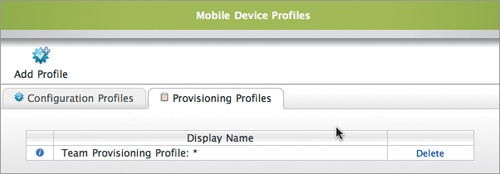
Then you’ll save the app out of Xcode, just as you did in Chapter 17, and add it to your MDM server (Figure 18.2).
Figure 18.2. Choosing to install an in-house app

When you upload the app, you’ll need to set up some basic information such as the app name, bundle ID, version, and description. The MDM server also allows you to upload the icon you’ll use for the app when distributing it to users.
You’ll then upload the app’s .ipa file and select the correct provisioning profile to use. Set the scope, or range, of iOS devices that can access this app, and then click Save (Figure 18.3).
Figure 18.3. Information for the in-house app
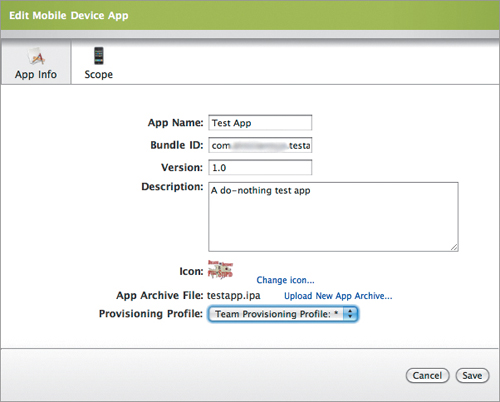
When you save, the provisioning profile, but not the app, will be uploaded to all devices in the device scope you set (Figure 18.4).
Figure 18.4. Provisioning profile installed on the device
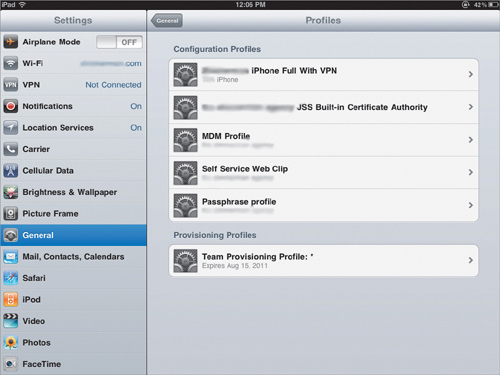
Installing the App
When the setup is done, the installation can proceed in several ways. In Casper’s case, it installs a self-service web application on each iOS device you enroll. Tapping that web application takes you to a webpage that lists available in-house apps, links to App Store apps, and displays updates to in-house apps (Figure 18.5).
Figure 18.5. In-house available app listing

Tapping the app icon displays the option to install the app and some information about it (Figure 18.6).
Figure 18.6. In-house app ready to install

I have no ability to write Objective-C code. This app does nothing but take up space and allow me to install and remove something for the applicable chapters in this book. As you’ll see later in this chapter, I have no color sense either.
Tapping Install displays the same “<server name> would like to install <app name>” dialog (Figure 18.7) that you see when you wirelessly install any in-house app. Install the app, and you’re ready to go.
Figure 18.7. In-house app installed
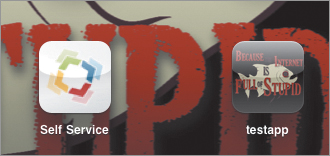
You may be wondering, “So what? All this has done is save me some work installing provisioning profiles and creating my own web-page.” Well, that’s partially correct. But the MDM server lets you do one thing that a home-built distribution method can’t (at least not as easily): You can check to see if the app has actually been installed (Figure 18.8). That’s kind of important, and an MDM server is well-suited to letting you know not only if the app has been installed, but which version (which is handy when you have to update the app).
Figure 18.8. Inventory for device showing in-house app installed with version number
![]()
So while this distribution method can’t give you the same installation confidence that you get from pushing an app, a decent MDM server does a good job of helping you figure out who’s installed what app and which version.
Updating an App
The initial app install is only part of the story. At some point, you’re going to update that app, and you’ll want to distribute it as easily as you distributed the initial version. MDM also makes this easy. In our example, we’ve made a minor, yet somewhat terrifying update to our app that we want to inflict upon the users.
To update the app, go into your MDM server and choose to edit the app you have uploaded. Then upload a new .ipa file, maybe a new icon, and change the version number. (You could also change the icon file and even the app name, if you’d like.)
The important thing not to change is the Bundle ID, which allows the MDM server to identify this change as an update to an existing app and not a completely new app (Figure 18.9).
Figure 18.9. Setting up updates to an in-house app
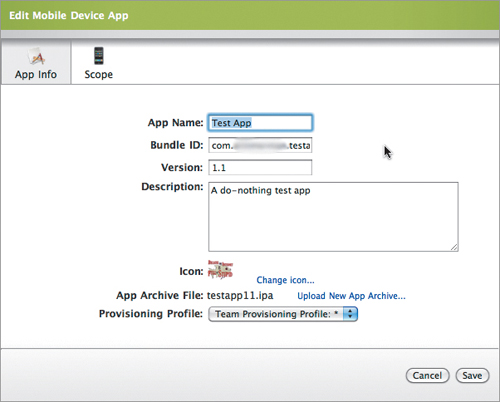
By retaining the Bundle ID, the new app version installs over the old one, so you won’t have two versions of the same app on every device in your company. That could be a bit confusing.
When you go back into Casper’s self-service web application, you’ll find an update available (Figure 18.10).
Figure 18.10. Available in-house app updates listing
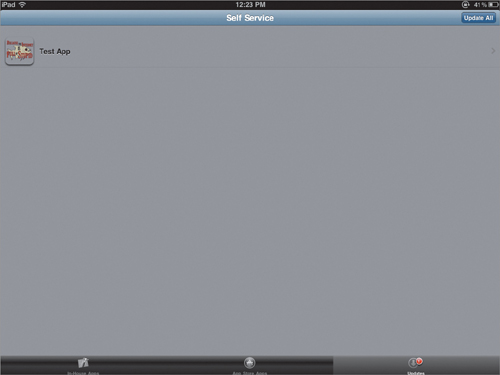
Install the update, and you go from an old boring app that (in this case) doesn’t do anything (Figure 18.11) to an equally unproductive but new, exciting, colorful version (Figure 18.12).
Figure 18.11. Version 1.0 of Test App

Figure 18.12. Version 1.1 of Test App

Managing App Store Apps
Wouldn’t it be nice if you could manage App Store apps the same way you manage in-house apps? Say you found an App Store app that’s really useful. Wouldn’t you like to buy a license for every iOS device in your company, and enable your users to install it quickly and easily? That would be awesome.
Well, if you’re in education, you’re set. Apple has an App Store Volume Purchase Plan (VPP) just for you. Literally. Just for education. It allows you to buy multiple copies of an app and generate app purchase codes. You distribution the codes to your users, who then go to the App Store, redeem the codes, and install the app. Life is good. If you’re not in education, well, you can’t do that. Life isn’t as good.
You can do some things to streamline App Store app management using your MDM server. You can create links to App Store apps that users can then use to simplify the installation process.
The procedure for setting this up is similar to setting up in-house apps (depending on your MDM server).
Set up your Mobile Device Management server to create a link to an App Store app. Enter the name of the app, and the country of the App Store you want to use (Figure 18.13).
Figure 18.13. Setting up a link to an App Store app
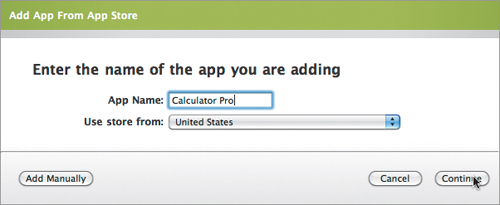
The MDM server will search the App Store for the app name and give you a list of results.
Pick the app you want to use, and the MDM server will pull down the actual app name, version, icon, and App Store URL (Figure 18.14).
Figure 18.14. Final information for link to App Store app
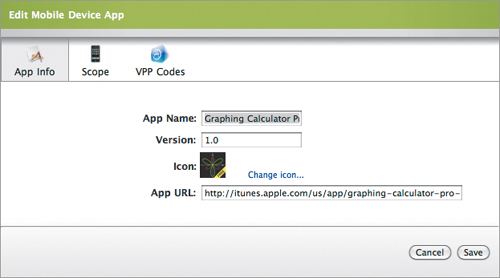
Set up the scope of iOS devices allowed to access this link, and click Save.
When the user opens up the self-service web application, he’ll see the app you set up in the App Store section (Figure 18.15).
Figure 18.15. Available App Store app listing

Tapping the app icon will take the user to the app’s entry in the App Store, where he can install it (Figure 18.16).
Figure 18.16. The app’s page in the App Store as displayed on the iOS device
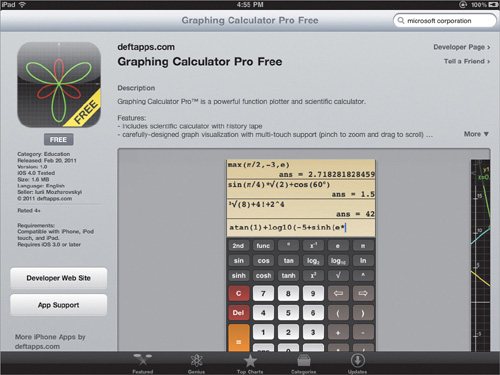
Wrapping Up
The method described in this chapter isn’t much of an improvement, but at least it lets you present a list of App Store apps for your users, and you can use your MDM server’s inventory features to see if they’ve installed the app.
